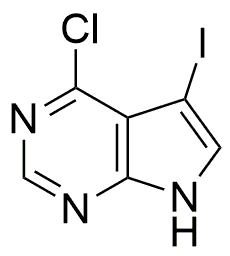6-Chloro-7-iodo-7-deazapurine is widely utilized in research focused on:
- Antiviral Drug Development: This compound plays a crucial role in the synthesis of antiviral agents, particularly in targeting viral replication processes, making it valuable in pharmaceutical research.
- Biochemical Research: It is used as a building block in the development of nucleoside analogs, which are essential for studying cellular processes and gene expression.
- Medicinal Chemistry: The compound serves as a lead structure for designing new drugs that can combat various diseases, including cancer, by inhibiting specific enzymes.
- Diagnostic Applications: Its derivatives are explored for use in diagnostic assays, enhancing the sensitivity and specificity of tests for certain diseases.
- Research in Molecular Biology: This chemical is utilized in the study of DNA and RNA interactions, providing insights into genetic regulation and potential therapeutic targets.
Informations générales
Propriétés
Sécurité et réglementation
Applications
6-Chloro-7-iodo-7-deazapurine is widely utilized in research focused on:
- Antiviral Drug Development: This compound plays a crucial role in the synthesis of antiviral agents, particularly in targeting viral replication processes, making it valuable in pharmaceutical research.
- Biochemical Research: It is used as a building block in the development of nucleoside analogs, which are essential for studying cellular processes and gene expression.
- Medicinal Chemistry: The compound serves as a lead structure for designing new drugs that can combat various diseases, including cancer, by inhibiting specific enzymes.
- Diagnostic Applications: Its derivatives are explored for use in diagnostic assays, enhancing the sensitivity and specificity of tests for certain diseases.
- Research in Molecular Biology: This chemical is utilized in the study of DNA and RNA interactions, providing insights into genetic regulation and potential therapeutic targets.
Documents
Fiches de données de sécurité (FDS)
La FDS fournit des informations de sécurité complètes sur la manipulation, le stockage et l’élimination du produit.
Spécifications du produit (PS)
Le PS fournit une description complète des propriétés du produit, notamment sa composition chimique, son état physique, sa pureté et les exigences de stockage. Il détaille également les plages de qualité acceptables et les applications prévues du produit.
Certificats d'analyse (COA)
Recherchez des certificats d'analyse (COA) en saisissant le numéro de lot du produit. Les numéros de lot et de lot se trouvent sur l'étiquette d'un produit, après les mots « Lot » ou « Lot de fabrication ».
Numéro de catalogue
Numéro de lot/série
Certificats d'origine (COO)
Ce certificat d'exploitation confirme le pays dans lequel le produit a été fabriqué, et détaille également les matériaux et composants utilisés et s'il est issu de sources naturelles, synthétiques ou autres sources spécifiques. Ce certificat peut être requis pour les douanes, le commerce et la conformité réglementaire.
Numéro de catalogue
Numéro de lot/série
Fiches de données de sécurité (FDS)
La FDS fournit des informations de sécurité complètes sur la manipulation, le stockage et l’élimination du produit.
DownloadSpécifications du produit (PS)
Le PS fournit une description complète des propriétés du produit, notamment sa composition chimique, son état physique, sa pureté et les exigences de stockage. Il détaille également les plages de qualité acceptables et les applications prévues du produit.
DownloadCertificats d'analyse (COA)
Recherchez des certificats d'analyse (COA) en saisissant le numéro de lot du produit. Les numéros de lot et de lot se trouvent sur l'étiquette d'un produit, après les mots « Lot » ou « Lot de fabrication ».
Numéro de catalogue
Numéro de lot/série
Certificats d'origine (COO)
Ce certificat d'exploitation confirme le pays dans lequel le produit a été fabriqué, et détaille également les matériaux et composants utilisés et s'il est issu de sources naturelles, synthétiques ou autres sources spécifiques. Ce certificat peut être requis pour les douanes, le commerce et la conformité réglementaire.


